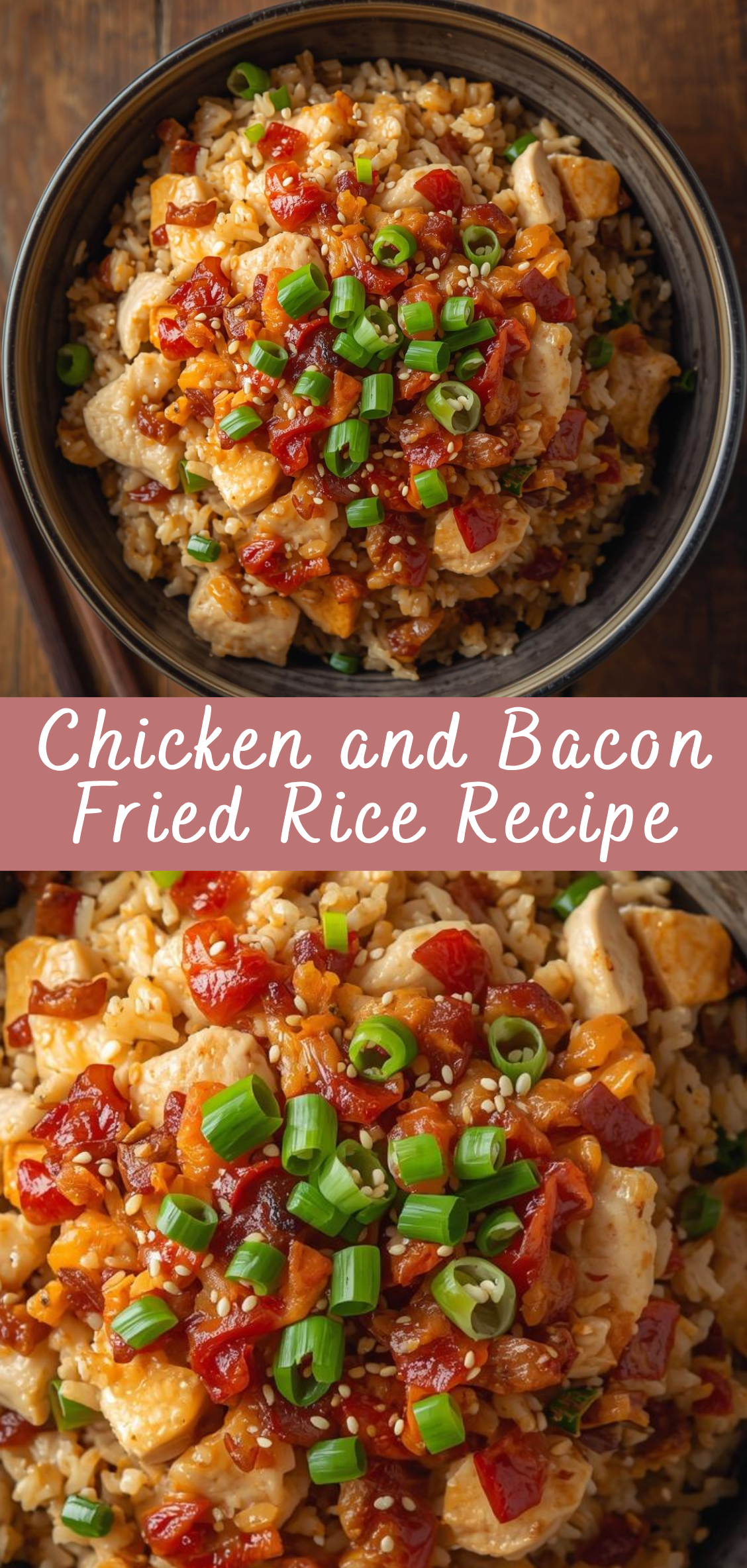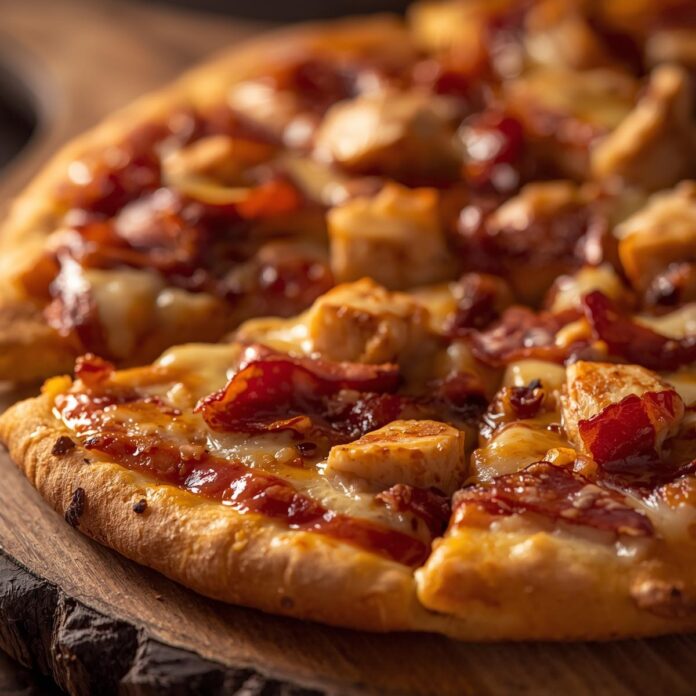Chicken and Bacon Fried Rice: A Harmony of Smoky, Savory, and Comforting Flavors
Few dishes capture the comfort and versatility of fried rice. What began centuries ago as a humble method of transforming leftover grains into something new and nourishing has evolved into a global culinary canvas — endlessly adaptable, instantly gratifying, and deeply satisfying. From the bustling night markets of Southeast Asia to home kitchens around the world, fried rice has become a symbol of creativity in simplicity. Into this versatile foundation enters a bold, modern twist: Chicken and Bacon Fried Rice, a dish that bridges Eastern technique with Western indulgence, yielding something both familiar and refreshingly new.

At its core, fried rice is a study in texture and timing. Each grain of rice must remain distinct — lightly crisped on the outside, yet tender and fragrant within. To achieve this balance requires not just ingredients, but intention: cold rice, high heat, and the confidence to move swiftly as flavors build in the wok. But when we introduce chicken and bacon into this traditional structure, the dish transforms. The smoky, salty bite of bacon and the tender, juicy richness of chicken fuse together, creating layers of umami that deepen with every mouthful.
The story of this dish begins with contrast — the interplay of East and West, simplicity and depth, comfort and sophistication. The use of bacon, though unconventional in traditional Chinese or Southeast Asian fried rice, adds a distinctly modern note. Its rendered fat doesn’t just season the meat; it infuses the entire dish with a smoky foundation that carries through every component. In contrast, the chicken provides substance and balance, absorbing flavors from the aromatics and sauce while maintaining its own tender identity.
Bacon’s presence introduces a textural complexity that sets this fried rice apart. When crisped properly, it shatters lightly between bites of soft rice and tender chicken, creating a rhythm of textures that elevates the dish beyond the ordinary. Meanwhile, the chicken — often marinated with a touch of soy sauce, sesame oil, and ginger — provides the familiar heartiness that anchors the dish. Together, they form a partnership that feels indulgent yet balanced, rich but never overwhelming.
Equally important is the rice itself, the soul of the dish. Fried rice is not merely a vehicle for toppings; it’s the medium that carries and harmonizes every flavor. The key lies in using rice that has been cooked and cooled, ideally overnight. This allows the grains to firm up and separate, resisting the sogginess that plagues many novice attempts. When tossed in a hot wok or skillet, each grain sears slightly, taking on the savory notes of bacon fat, soy, and aromatics like garlic, scallion, and onion.
Beyond its flavor, Chicken and Bacon Fried Rice tells a story of resourcefulness — the way home cooks across cultures transform what’s available into something remarkable. It celebrates the marriage of leftover rice, the end slices of bacon, a bit of chicken from yesterday’s roast, and a few vegetables lingering in the crisper. With technique and imagination, these simple components become something extraordinary: a dish that feels both comforting and exciting, rustic and refined.
Another key element that elevates this recipe is balance. Fried rice succeeds when every component knows its role. Bacon provides the smoky saltiness, chicken delivers protein and mild savor, aromatics such as garlic, onion, and scallion lend fragrance, while soy sauce, oyster sauce, and a hint of sesame oil weave everything together into a cohesive, umami-rich symphony. Even the vegetables — peas, carrots, corn, or bean sprouts — play a critical role, adding color, freshness, and textural variation that keep each bite dynamic.
Culinarily, this dish bridges technique and instinct. The process relies on quick, deliberate motions — the toss of the wok, the sizzle of ingredients hitting hot metal, the layering of flavors in precise sequence. Yet it also invites intuition. You adjust heat by feel, season by taste, and balance textures by eye. This adaptability is what makes fried rice endlessly rewarding: once you master the foundation, it becomes a template for creativity, whether you’re cooking for yourself after a long day or preparing a feast for friends.
In this recipe, we will explore each step in detail: how to prepare the perfect rice, render bacon for maximum flavor, marinate and sear chicken for juiciness, and coordinate aromatics and sauces so that every element contributes without overwhelming the rest. You’ll learn not only the how, but the why — the logic behind the order of ingredients, the control of heat, and the subtle science that transforms humble leftovers into a restaurant-quality meal.
Beyond the technical, Chicken and Bacon Fried Rice speaks to something deeply human: the comfort of familiar flavors meeting new ones, the warmth of a home-cooked meal shared at the table, and the joy of transforming simple ingredients into something that tastes greater than the sum of its parts. Whether you’re a seasoned cook seeking a satisfying twist on a classic or a beginner eager to master the fundamentals of stir-frying, this dish offers both a learning experience and a reward.
As we move through this comprehensive guide — from ingredient selection to final garnish — you’ll gain more than just a recipe. You’ll understand how to control texture, how to balance savory and sweet, and how to build a fried rice dish that reflects your own preferences. The journey ahead isn’t merely about replicating flavor; it’s about mastering a process that’s as adaptable as it is delicious.
So, gather your wok, prepare your ingredients, and get ready to stir, toss, and taste your way through one of the most satisfying comfort foods imaginable. Smoky, hearty, and endlessly customizable, Chicken and Bacon Fried Rice is more than a recipe — it’s a celebration of what happens when culinary traditions collide to create something truly unforgettable.
Detailed Instructions: How to Make Chicken and Bacon Fried Rice
Cooking Chicken and Bacon Fried Rice is an art form that balances precision and intuition. The process requires understanding not only how to execute each step but also why each step matters. The following instructions walk through the entire process — from preparation to plating — ensuring that every grain of rice is infused with the perfect harmony of flavors.
1. Preparation: Setting the Foundation
Before turning on the stove, successful fried rice begins with proper preparation. The concept of “mise en place,” a French term meaning “everything in its place,” is essential here. Each component should be chopped, measured, and ready before you start stir-frying, as the actual cooking process moves very quickly.
Ingredients
-
4 cups of cooked and chilled jasmine rice (preferably day-old)
-
250 grams (about 2 cups) of boneless chicken breast or thigh, diced
-
150 grams (about 1 cup) of smoked bacon, chopped into small pieces
-
3 large eggs
-
1 medium onion, finely chopped
-
3 cloves of garlic, minced
-
1 cup of mixed vegetables (such as peas, carrots, and corn)
-
2 tablespoons of soy sauce
-
1 tablespoon of oyster sauce (optional for extra umami)
-
1 teaspoon of sesame oil
-
2 tablespoons of vegetable or peanut oil
-
Salt and pepper, to taste
-
2 green onions, finely sliced for garnish
Key Preparation Steps:
-
Rice: The rice should be cooked at least several hours in advance — ideally the day before. Freshly cooked rice tends to be too moist and sticky, which prevents it from frying properly. Spread freshly cooked rice on a tray to cool if you must use it immediately.
-
Chicken: Dice the chicken into small, bite-sized cubes to ensure even cooking. You may marinate it lightly with a teaspoon of soy sauce, a pinch of pepper, and a few drops of sesame oil for about 10–15 minutes.
-
Bacon: Cut the bacon into uniform pieces. The fat rendered from the bacon will later serve as part of your cooking oil, enhancing the depth of flavor.
-
Vegetables: Prepare your vegetables in advance. If using frozen ones, allow them to thaw and drain excess water.
2. Cooking the Proteins
Fried rice relies on layering flavors, and this begins with the proteins. Cooking the chicken and bacon separately helps to control texture and prevent overcrowding in the pan.
-
Render the Bacon Fat:
-
Place a large wok or heavy skillet over medium heat.
-
Add the chopped bacon and cook slowly, allowing the fat to render out.
-
Stir occasionally until the bacon turns golden and slightly crisp. This process should take about 5–7 minutes.
-
Using a slotted spoon, remove the bacon and set it aside, leaving about 1 tablespoon of bacon fat in the pan. If there is excess fat, drain it into a small bowl — you may need it later for additional flavoring.
-
-
Cook the Chicken:
-
Increase the heat to medium-high.
-
Add a small drizzle of oil (or reserved bacon fat) if needed.
-
Add the diced chicken to the pan in a single layer. Let it sear undisturbed for 30 seconds before stirring.
-
Continue to cook for 3–4 minutes until the chicken is lightly browned and cooked through.
-
Season with a small pinch of salt and pepper, then remove the chicken and set it aside with the bacon.
-
3. Aromatics: Building the Base Flavor
Aromatics form the backbone of fried rice flavor. The combination of garlic and onion, gently fried in residual fat, creates a fragrant foundation that elevates every other ingredient.
-
Sauté the Aromatics:
-
In the same pan, reduce the heat slightly to medium.
-
Add a teaspoon of fresh oil or reserved bacon fat if the pan is dry.
-
Add the chopped onion and sauté for about 2 minutes, until translucent.
-
Add the minced garlic and stir constantly for 30 seconds, ensuring it doesn’t burn.
-
The aroma at this stage should be rich and slightly sweet — a sign that the flavor base is ready.
-
4. Eggs: The Soft Element
Eggs are a signature component of most fried rice dishes, providing richness and cohesion.
-
Scramble the Eggs:
-
Push the sautéed onions and garlic to one side of the wok.
-
Add a small drizzle of oil to the empty side.
-
Crack the eggs directly into the pan and let them sit for a few seconds before stirring gently.
-
Scramble until they are mostly cooked but still slightly soft — they will finish cooking when the rice is added.
-
Mix the eggs lightly with the aromatics.
-
5. Incorporating the Rice
Now comes the defining step — adding the rice and transforming it from plain grains into a flavorful centerpiece.
-
Add the Chilled Rice:
-
Break up any clumps of rice with your hands or a spoon before adding it to the wok.
-
Spread the rice evenly across the surface and let it sit undisturbed for 20–30 seconds to absorb heat.
-
Stir-fry vigorously, lifting and tossing the rice to ensure it heats evenly.
-
If your wok is large enough, toss the rice in quick, upward motions to encourage separation and even coating.
-
-
Seasoning and Flavor Building:
-
Pour in the soy sauce and oyster sauce evenly over the rice, stirring continuously so every grain is coated.
-
Add a small drizzle of sesame oil for aroma.
-
Season with pepper to taste. Avoid adding too much salt early, as both soy sauce and bacon are already salty.
-
6. Combining All Ingredients
Now it’s time to bring all elements together for the final integration of flavor.
-
Return the Chicken and Bacon:
-
Add the cooked chicken and bacon back into the pan.
-
Toss thoroughly to combine with the rice and aromatics.
-
Continue stir-frying for 2–3 minutes to reheat the proteins and distribute the flavors.
-
-
Add Vegetables:
-
Add your prepped vegetables (peas, carrots, corn, or any mix of choice).
-
Stir-fry until the vegetables are heated through but still vibrant in color and slightly crisp.
-
Adjust seasoning with an extra dash of soy sauce or pepper if needed.
-
7. Achieving “Wok Hei”
“Wok hei,” literally translated as “breath of the wok,” refers to the smoky, slightly charred aroma that comes from cooking at high heat. This is the hallmark of authentic fried rice.
To achieve this:
-
Use high heat and work quickly to prevent steaming.
-
Do not overcrowd the wok; if necessary, cook in batches.
-
Allow brief moments where ingredients rest on the hot surface without stirring — this caramelizes the rice slightly, enhancing its aroma.
8. Finishing Touches
-
Final Stir:
-
Once the rice is evenly mixed and fragrant, turn off the heat.
-
Add sliced green onions and toss gently to distribute their fresh aroma.
-
-
Taste Test:
-
Taste the fried rice before serving.
-
Adjust seasoning — a dash of soy sauce for salt, a sprinkle of pepper for spice, or a few drops of sesame oil for depth.
-
-
Serving:
-
Serve the Chicken and Bacon Fried Rice immediately while hot.
-
Garnish with additional green onions or a light sprinkle of crispy bacon bits for texture.
-
9. Tips for Perfection
-
Use a Wok: A wok’s shape ensures even heat distribution and better control when stir-frying.
-
Avoid Overcrowding: Too many ingredients lower the temperature and cause steaming instead of frying.
-
Day-Old Rice Rule: Always use rice that has cooled and dried slightly to achieve ideal texture.
-
Balance Flavors: The interplay of salty bacon, savory chicken, and umami-rich sauces defines the dish’s success. Taste as you go.
Chicken and Bacon Fried Rice Recipe
Few dishes capture the comfort and versatility of fried rice. What began centuries ago as a humble method of transforming leftover grains into something new and nourishing has evolved into a global culinary canvas — endlessly adaptable, instantly gratifying, and deeply satisfying. From the bustling night markets of Southeast Asia to home kitchens around the world, fried rice has become a symbol of creativity in simplicity. Into this versatile foundation enters a bold, modern twist: Chicken and Bacon Fried Rice, a dish that bridges Eastern technique with Western indulgence, yielding something both familiar and refreshingly new.
Ingredients
- 2 cups cooked and cooled rice (preferably day-old, jasmine or long-grain)
- 2 chicken breasts, diced (about 1 pound / 450 g)
- 4 slices bacon, chopped
- 2 eggs, lightly beaten
- 1 small onion, finely chopped
- 2 cloves garlic, minced
- 1 cup frozen peas and carrots (or mixed vegetables)
- 3 green onions, sliced
- 2 tbsp soy sauce (to taste)
- 1 tbsp oyster sauce (optional, for depth of flavor)
- 1 tsp sesame oil
- 2 tbsp vegetable oil (for frying)
- Salt and pepper, to taste
Instructions
1. Cook the Bacon
- In a large skillet or wok, cook the chopped bacon over medium heat until crispy.
- Remove the bacon with a slotted spoon and set aside. Leave about 1 tablespoon of bacon fat in the pan.
2. Cook the Chicken
- Add diced chicken to the pan with the bacon fat.
- Season lightly with salt and pepper, and cook until browned and fully cooked (about 5–6 minutes).
- Remove chicken and set aside with the bacon.
3. Scramble the Eggs
- In the same pan, add a little oil if needed.
- Pour in the beaten eggs and scramble until just set.
- Push to one side of the pan.
4. Sauté Aromatics and Veggies
- Add a bit more oil if needed.
- Sauté onion and garlic for 1–2 minutes until fragrant.
- Add peas and carrots (or mixed vegetables) and cook for another 2–3 minutes.
5. Add the Rice
- Add the cooked, cooled rice to the pan. Break up any clumps with a spatula.
- Pour in soy sauce, oyster sauce (if using), and sesame oil.
- Stir-fry for 2–3 minutes, coating the rice evenly with the sauces.
6. Combine Everything
- Add the cooked chicken and bacon back to the pan.
- Mix well and stir-fry for another 2–3 minutes.
- Taste and adjust seasoning with extra soy sauce or salt if needed.
- Stir in green onions at the end.
7. Serve
- Serve hot, topped with extra green onions or a drizzle of sriracha for heat.
Notes
- Best Rice: Day-old rice is ideal because it’s drier and fries better.
- Add-Ins: Try adding diced bell peppers, corn, or mushrooms for extra veggies.
- Make It Spicy: Add chili flakes or a spoon of chili oil.
- Meal Prep Tip: Cook extra rice and protein to make another batch later in the week.



